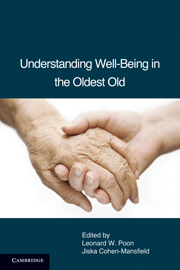Book contents
- Frontmatter
- Contents
- List of Tables
- List of Contributors
- Foreword by Carol D. Ryff
- PART I THEORY: NEW HORIZONS IN WELL-BEING RESEARCH
- PART II PARADISE LOST: BETWEEN TRAUMA AND HAPPINESS
- PART III PATHWAYS AND GATEKEEPERS: MODERATING, MEDIATING, AND PROXIMAL PROCESSES
- 9 Impact of Resources on Successful Adaptation among the Oldest Old
- 10 Nutrition and Well-Being
- 11 Cognitive Functioning and Vitality among the Oldest Old: Implications for Well-Being
- 12 Social Relationships and Well-Being in Very Late Life
- 13 Spirituality and Religiosity Connections to Mental and Physical Health among the Oldest Old
- 14 The Impact of Leisure Activity and Innovation on the Well-Being of the Very Old
- PART IV SIGNPOSTING PARADISE: MEASUREMENT OF WELL-BEING
- Index
- References
13 - Spirituality and Religiosity Connections to Mental and Physical Health among the Oldest Old
Published online by Cambridge University Press: 05 August 2012
- Frontmatter
- Contents
- List of Tables
- List of Contributors
- Foreword by Carol D. Ryff
- PART I THEORY: NEW HORIZONS IN WELL-BEING RESEARCH
- PART II PARADISE LOST: BETWEEN TRAUMA AND HAPPINESS
- PART III PATHWAYS AND GATEKEEPERS: MODERATING, MEDIATING, AND PROXIMAL PROCESSES
- 9 Impact of Resources on Successful Adaptation among the Oldest Old
- 10 Nutrition and Well-Being
- 11 Cognitive Functioning and Vitality among the Oldest Old: Implications for Well-Being
- 12 Social Relationships and Well-Being in Very Late Life
- 13 Spirituality and Religiosity Connections to Mental and Physical Health among the Oldest Old
- 14 The Impact of Leisure Activity and Innovation on the Well-Being of the Very Old
- PART IV SIGNPOSTING PARADISE: MEASUREMENT OF WELL-BEING
- Index
- References
Summary
ABSTRACT
Gerontological examination of spiritual and religious connections in extreme old age has been limited. The purpose of this paper was to expose the connection between religious coping and mental and physical health among centenarians at time 1 and time 2. This involved an examination and identification of longitudinal predictors of religious coping among persons living extremely long lives. It appears that gender, health impairment, and negative affect may represent key predictors of religious coping in extreme old age. Furthermore, religious coping seems to diminish negative affect but increases feelings of stress. This has implications relative to improving theoretical conceptualization and cross-cultural insight into how religious coping contributes to adaptation in very old age. Suggestions for future spirituality and religiosity research with very old populations are highlighted.
INTRODUCTION
Many older adults seek the sacred. Investigators have acknowledged that religious and spiritual behaviors serve as personal resources that improve adaptation and protection against poor physical and mental functioning (Krause, 2006; Pargament, 1997). Although robust physical and mental health status are desirable characteristics in very old age (Quinn, Johnson, Poon, & Martin, 1999; Samuelsson et al., 1997), most exceptionally old persons experience multiple health ailments that threaten individual well-being (Jang, Poon, & Martin, 2004).
- Type
- Chapter
- Information
- Understanding Well-Being in the Oldest Old , pp. 227 - 239Publisher: Cambridge University PressPrint publication year: 2011
References
- 8
- Cited by



